

![]() The English Apple Man arrived back in UK on Wednesday morning; the season here is on the move; surprised to see our 'our flowering cherry is in full bloom' with a more consistent week of warmer weather driving the advance in spring flowers and fruit bud!
The English Apple Man arrived back in UK on Wednesday morning; the season here is on the move; surprised to see our 'our flowering cherry is in full bloom' with a more consistent week of warmer weather driving the advance in spring flowers and fruit bud!
The weather pattern this season has been quite different from the last two seasons, with prolonged, very cold and snowy weather in 2009/2010 & 2010/2011.
Last season was an almost perfect build up to bud burst, the cold weather held fruit bud back before the upsurge in temperature accelerated bud movement and ultimately the earliest blossom period in nearly 40 years.
The cold held firm until the end of March and then warmed up dramatically; an ideal precursor to a fertile blossom and fruit set. This year we are faced with inadequate fruit bud in some orchards/varieties, with Cox, Bramley, Braeburn and even some Gala lacking fruit bud where orchards were stressed last summer, especially where orchards lacked irrigation.
East Malling Research - Pear Conference - 27th March 2012.
Readers of the past two Journals will be familiar with presentation notes from key speakers. This week the EAM will conclude the 'round up' of the remaining speakers.
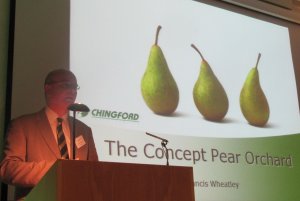 Francis Wheatley - Chingford Fruit Packers
Francis Wheatley - Chingford Fruit Packers
In the first presentation after lunch, Francis reminded the audience of the potential for UK grown pears. With a total pear market in the UK worth £165.9 million and a Conference Pear market worth £88.3 million; equal to 53% of the total market share, there is a massive opportunity for UK growers and Consumers to enjoy the mutual benefit of an increase in UK production.
To put it simply; UK Conference constitute only 19% of all pears sold in the UK and only 36% of all the Conference sold in the UK.
This Francis pointed out is gap in the UK pear market of £57,000,000 for UK Conference. The opportunity is huge!
With UK consumers becoming more interested in 'locally' sourced food, and the determination of Sainsburys to double home grown procurement by 2020, the opportunity for UK growers is there for the ambitious.
The objective of the Concept Orchard and The Sweet Sensation Orchard, both established at East Malling Research, is to demonstrate with the use of 'best practice' the capability of home grown pear production as a profitable enterprise.
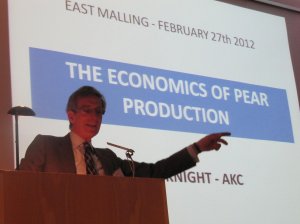 David Knight - AKC Agriculture
David Knight - AKC Agriculture
David Knight is a fruit grower from Pembury in West Kent, and an adviser on the economics of top fruit growing. With a B.Sc (Hons Agric) M.Sc (Ag Econ) David is well qualified in the academic and practical planning of new orchards.
His presentation majored on the importance of assessing accurately all the cost parameters before planting a new orchard. David said there are very little data available to growers. DEFRA surveys, and occasional specific projects give a limited area of assistance.
David looked at the economics from the time of planting, through subsequent harvests, to the eventual point of sale to the consumer. He focused on the three main areas of pear production - growing, marketing and retailing. His aim was to highlight the principles and figures inherent in the whole process.
EAM comment! The value of the EMR Concept Orchard, allied to David's pragmatic cost analysis, will enable a much more detailed approach for growers planning future pear orchards in the UK. Without doubt, with the very high investment involved, it would be foolish to venture forth without a detailed budget forecast.
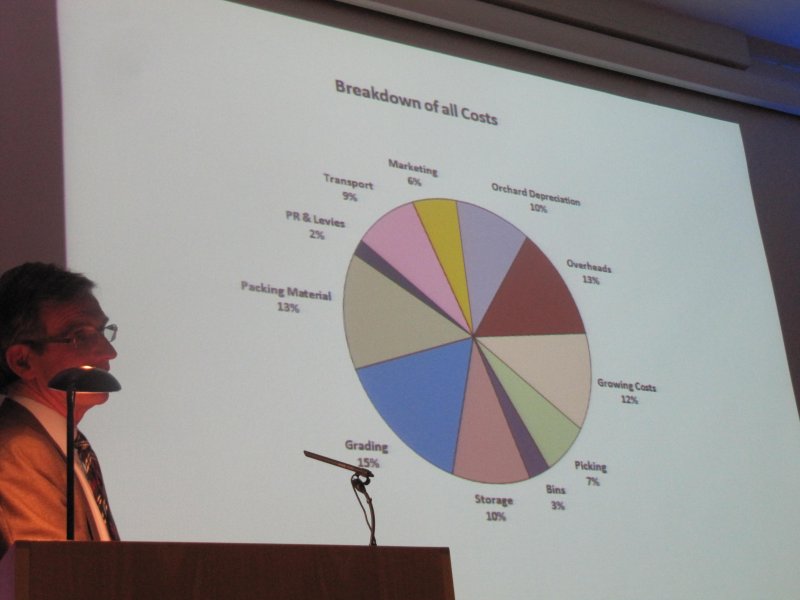
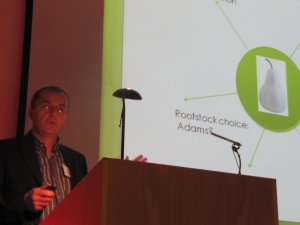 Leon Jahae - Agrovista; Optimising the performance of Conference Pears
Leon Jahae - Agrovista; Optimising the performance of Conference Pears
Leon has extensive experience of top fruit production all over Europe and as an adviser based in England for many years, has applied his considerable knowledge to challenging the preconception that we cannot compete with our competitors in the Benelux countries.
Leon demonstrated the key factors essential for consistent yields of good quality pears. When planting new orchards; Site selection, Rootstock choice, Irrigation, Planting system, Soil sampling and Production targets, must ALL be carefully considered and 'best practice' complied with.
Site selection requires a sheltered position with rows planted in a north/south direction. Leon recommends Quince Adams rootstock (Quince C should only be contemplated for the very best soils) and stresses the importance of keeping the planting system simple. Good establishment is very important, the benefits will be found in performance in future years. Irrigation will play an important role. Leon said 40 tonnes per hectare IS a realistic target.
When revitalizing established orchards, Leon illustrated the performance of a pear orchard in Wisbech. Planted 23 years ago in 1989, production has risen from its previous 23 tonnes per hectare to 41 tonnes in 2011. In 2007 the yield was 25 tonnes with an average fruit size of 55mm. By using Klik-pruning to ensure a well balanced tree and introducing mechanical pruning which has halved the pruning costs, the yield has risen steadily; 2008 - 26 tonnes. 2009 - 30 tonnes. 2010 - 37 tonnes and 20111 - 41 tonnes. The size profile has improved from 55mm in 2007 - 67 mm in 2011. This dramatic improvement is the critical element in the increase in yield; 'larger fruit size = higher yield'
The Pear Conference concluded with presentations by resident East Malling Research scientists, Professor Jerry Cross and Dr. Mark Else, dealing with pear sucker management and water research on pear growing.
Professor Jerry Cross - Pear Sucker management.
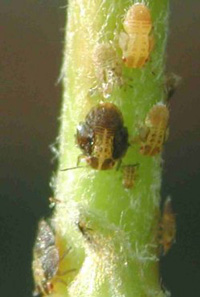
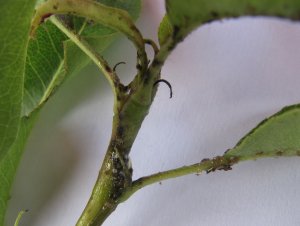 Pear Sucker; that destroyer of pear crops is always high on the agenda when growers assess the challenges facing profitable pear growing. The need for research into controlling this 'pesky' creature is being addressed by a DEFRA - Horticultural LINK programme and as an industry we are fortunate to have the perceptive mind of Jerry Cross to lead the team searching for an effective pear sucker control.
Pear Sucker; that destroyer of pear crops is always high on the agenda when growers assess the challenges facing profitable pear growing. The need for research into controlling this 'pesky' creature is being addressed by a DEFRA - Horticultural LINK programme and as an industry we are fortunate to have the perceptive mind of Jerry Cross to lead the team searching for an effective pear sucker control.
Pear sucker (Psylla pyricola) infestations have become more common in recent years with some pear orchards carrying large, established populations. The adoption of integrated control programs, incorporating the use of effective insecticide treatments, is very important as a means of reducing the damage this pest can cause.
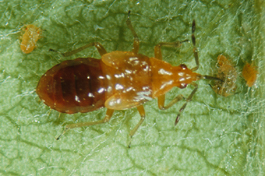 Feeding by Pear sucker nymphs occurs in the spring on developing leaf and blossom trusses and continues through the summer on leaves. Heavy infestations can cause complete kill of developing blossoms. A secondary symptom of Pear sucker attack is the development of sooty moulds in the honeydew secreted by the nymphs. This leads to blackened shoots and foliage, sometimes affecting the fruit as well.
Feeding by Pear sucker nymphs occurs in the spring on developing leaf and blossom trusses and continues through the summer on leaves. Heavy infestations can cause complete kill of developing blossoms. A secondary symptom of Pear sucker attack is the development of sooty moulds in the honeydew secreted by the nymphs. This leads to blackened shoots and foliage, sometimes affecting the fruit as well.
The key to successful control depends primarily on an adequate supply of predators. Chief predator is the 'Anthocorid predatory bug. Two species predominate; Anthocoris nemoralis, a species that prefers to feed on the psyllids which can occur earlier in the season and Anthocoris nemorum, a species more adapted to aphids which occur later in the season. 'Both' are important predators, but neither 'overwinter' in pear orchards in any numbers, but migrate in from hedgerows etc. a few weeks after blossom time. Anthocorids are highly mobile and have a relatively fast numerical response to their prey; they also have two generations each season.
There are other valuable predators; Earwigs, Ladybirds, especially Harlequin Ladybirds and even species of Spiders support the 'front line troops' Anthocorids in the battle to control pear sucker. The management of pesticides, important for controlling other pests and diseases is key to winning the battle.
If Jerry and his colleagues at EMR can inspire a cost effective & environmentally friendly control of pear sucker, our Pear Industry will take a great leap forward.
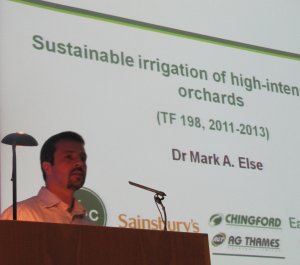 Dr. Mark Else - Application of water research on pear growing.
Dr. Mark Else - Application of water research on pear growing.
"Developing water, and fertiliser saving strategies, to improve fruit quality and sustainability of irrigated high intensity, modern and traditional pear production"
This is the objective summary of Mark's research and with forecasts of climate changing influence on water availability, this research is a key element in our ability to produce high yields of quality pears.
Mark told us the canopy structure of the different high intensity systems, can be expected to result in very different irrigation requirements. In this HDC funded work (Horticultural Development Council) "we are developing targeted irrigation strategies to optimise water use efficiency, yields and fruit quality for each growing system" be it; V system, double leader or single leader 'run through' in practice this meant using Irrigation test regimes (ITR's) in 2011 based on soil matric potential that match demand with supply and reduce losses of water and fertiliser past the rooting zone. The effects of the ITR's on shoot extension growth and fruit quality are currently being determined. In addition the consequences for shelf life potential are being assessed in on-going work funded by AG Thames. The impacts of the ITR's on return bloom will be assessed in the spring of 2012.
During 2012 the ITR's will be applied from six weeks after petal fall until September.
The research will provide guidelines enabling growers to optimise water and nutrient use efficiencies in modern and high intensity growing systems on different soil types in our UK pear orchards.
The English Apple Man summary.
The Pear Conference was an excellent event with a great deal of important information put before the attendees. From the 'vibes' of growers at the Conference it was clear many still feel the high investment in UK pear production is not their favoured route, preferring apples as their investment choice.
However, there are (I think) sufficient numbers prepared to take the plunge!
What is the anticipated format?
Site selection (micro climate) and soil type (a naturally high water table is ideal) is a prerequisite, irrigation a MUST do. Tree system will almost certainly rely on close planted (1 metre) format with a double leader the favoured choice. Choice of clone and rootstock (Quince Adams) an important decision. Support system (post & wire) and pest control; especially "Pear Sucker" will depend on an astute 'balance' of chemical sprays & predator management.
Certainly it would be prudent of any pear grower to take serious account of David Knight's costings breakdown when assembling a budget forecast.
The 'proof of the pudding' will take some years to be known, but if Michael Bentley has found the formula we will have a good idea within 5 years.
Until next week;
Take care
The English Apple Man